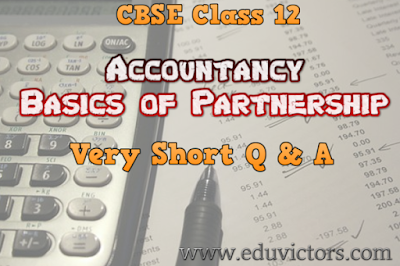Accountancy - Basics of Partnership - Short Questions and Answers
Q1: Define partnership.
Answer: When two or more persons enter into an agreement to carry on business and share its profit and losses, it is a case of partnership. The Indian partnership Act, 1932, defines Partnership as follows:
"Partnership is the relation between persons and who have agreed to share the profits of a business
carried on by all or any of them acting for all."
Q2(CBSE 2017): Does partnership firm has a separate legal entity ? Give reason in support of your answer.
Answer: As per law the partners and partnership firm have no separate legal entities.
Q3: What do you understand by 'partners', 'firm' and 'firms' name?
Answer: The persons who have entered in to a Partnership with one another are individually called 'Partners' and collectively 'a firm' and the name under which the business is carried is called 'the firm's name'.
Q4: Six friends started a partnership business by investing ₹2,00,000 each. They decided to share profit equally. Name the terms by which they will be called individually and collectively.
Answer: Individually : Partners
Collectively : Firm
Q5: What is the minimum and maximum number of partners in all partnership?
Answer: There should be at least two persons to form a Partnership. The maximum number of Partners in a firm carrying an banking business should not exceed ten and in any other business should not exceed ten and in any other business it should not exceed twenty.
Q6: Would a ‘charitable dispensary’ run by 8 members be deemed as partnership firm ? Give
reason in support of your answer.
Answer: No, a ‘Charitable dispensary’ run by 8 members cannot be deemed to be a partnership firm
because:
(i) For partnership, there must be a business.
(ii) There must be sharing of profits among the partners from such business. In this case, there is
no business and no sharing of profits.
Q7: What is the status of partnership from an accounting viewpoint?
Answer: From an accounting viewpoint, partnership is a separate business entity. From legal viewpoints, however, a Partnership, like a sole proprietorship, is not separate from the owners.
Q8: What is meant by partnership deed?
Answer: Partnership deed is a written agreement containing the terms and conditions agreed by the partners.
Q9: What is a sleeping or dormant partner?
Answer: Sleeping or Dormant Partners : These partners only provide capital and also share the profits and losses of the business. A sleeping partner does not take part in the management of a firm. These are not known to public as partners.
Q10: In the absence of a partnership deed, how are mutual relations of partners governed?
Answer: In the absence of Partnership deed, mutual relations are governed by the Partnership Act, 1932.
Q11(MCQ): In the absence of Partnership Deed, the profits of a firm are divided among the partners:
(a) In the ratio of Capital
(b) Equally
(c) In the ratio of time devoted for the firm’s business
(d) According to the managerial abilities of the partners.
Answer: (b) Equally
In the absence of partnership deed or if deed is silent, profits of a firm are divided among the partners equally.
Q12: Why is it important to have a partnership deed in writing?
Answer: Partnership deed is important since it is a document defining relationship of among Partners thus is assistance in settlement of disputes, if any and also avoids possible disputes: it is good evidence in the court.
Q13: What do you understand by fixed capital of partners?
Answer: Partners' capital is said to be fixed when the capital of Partners remain unaltered except in the case where further capital is introduced or capital is withdrawn permanently.
Q14: What do you understand by fluctuating capital of partners?
Answer: Partner’s capital is said to be fluctuating when capital alters with every transaction in the capital account. For example, drawing, credit of interest, etc.
Q15(CBSE SQP): A Partnership deed provides for the payment of Interest on Capital but there was a loss instead of profits during the year 2010-2011. At what rate will the interest on capital be allowed ?
Answer: No interest on capital will be allowed.
Q16: Is a sleeping partner liable for the acts of other partners?
Answer: Yes, a sleeping partner is also liable for the acts of other partners.
Q17: If the partners capital accounts are fixed, where will you record the following items :
i) Salary to partners
ii) Drawing by a partners
iii) Interest on capital and
iv) Share of profit earned by a partner?
Answer:
i) Credit side of Partner's current A/c
ii) Debit side of Partner's current A/c
iii) Credit side of Partners current A/c
iv) Credit side of Partners current A/c
Q18(CBSE 2016): What is meant by ‘Fluctuating Capital’ of a Partner?
Answer: A method of presenting capital accounts of partners where all the adjustments regarding
interest on capital, drawings, share of profit etc. are recorded directly in the capital account.
Q19(CBSE SQP): Name the accounts which are maintained for the partners when capitals of the partners are fixed.
Answer: Partner’s Capital Account and Partner’s Current Account are maintained when the capitals of partners are fixed.
Q20: Ramesh, a partner in the firm has advanced a loan of a Rs. 1,00,000 to the firm and has demanded on interest @ 9% per annum. The partnership deed is silent on the matter. How will you deal with it?
Answer: Since the Partnership deed is silent on payment of interest, the provisions of the Partnership Act, 1932 will apply. Accordingly, Ramesh is entitled to interest @ 6% p.a.

